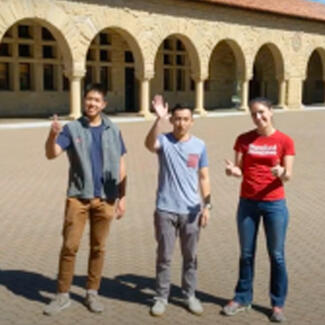
Q: What do career day, secret codes, and fantasy football have in common? A: EE 276: Information Theory
Students from EE276 created videos for middle school students in lieu of the planned in-person outreach event.
Because of the COVID-19 pandemic, Professor Tsachy Weissman's Information Theory class transformed their in-person outreach event into a digital version. The students prepared videos that present an aspect of information theory, geared toward middle school students. EE276 students could also create blog entries as part of their coursework.
Students from EE276 created videos for middle school students in lieu of the planned in-person outreach event.
The outreach goal of the class is to teach middle school students a range of topics related to information theory. Some teams talk about mapping political landscapes while others delve into the theory of code breaking. Some groups demonstrate military applications when flying jets and others show information theory through Fortnite (https://www.epicgames.com). Each video presentation is unique and appeal to various interests and learning styles of students in middle school.
Tsachy and EE276 students encourage the use of their videos and blogs to help teach and understand concepts in information theory. Outreach project videos are listed below, those with related blogs are also included.
- Audio Lossy Compression Game (Timothy Chong)
- Bioinformatics (Christian A Choe and Raphael R Eguchi)
- Brain Computer Interfaces (Iliana Bray and Persiana S Saffari)
- Career Day (Liz Leckie, Jonathan J Mak, and Kevin H Tang) Read blog
- Compressed Sensing and Quantum Tomography (Beicheng Lou and Evan Laksono) Read blog
- Compression (Wei H Chao)
- Compression of Quantum Information (Tim Chen) Read blog
- Controlling Video Games with Thoughts BMI (Pumiao Yan)
- Elections (Sandy Handan Nader) Read blog
- Error Correcting Codes (Alexandre M Bucquet, Colleen Dai, Diwakar Ganesan, and Madison N Hurr) Read blog
- Federated Learning (Saelig Ashank Khattar, Andrew Wang)
- How the brain can help us understand information theory (Praveen N Pallegar and Maxim Serebriakov)
- Huffman Encoding (Katherine Kowalski, Calvin Lin, and Yasmeen Jassim) Read blog
- Image To Image Translation (Yue Li, Yawen Sun, Yahan Yang)
- Information Manipulation (John Asigbekye and Meghaha V Rao) Read blog
- Information of Popular Communication Methods (Alissa S Ling and Arun Seetharaman) Read blog
- Information Theoretic Motivation For GANs (Andrew A Miller Smith) Read blog
- Information theory and alphabet (Trisha Jani)
- Information Theory In Music (Paavani Dua and Jonas Messner)
- Informational entropy of standardized testing (Ellie R Bowen, Nathan A Fotedar)
- Learned Image Compression (Helena Huang, Boxiao Pan, and Yanpei Tian) Read blog
- LED Displays (Natalie K Gable and Sarah R Woodard) Read blog
- Lossless and lossy compression of material decomposition images from dual energy CT (Yirong Yang) Read blog
- Machine learning (Adeline E Wong)
- Mind Body Problems (Viraga Perera)
- Model Of Brain Lesions (Aaron R Altman and Arjun K Dhawan)
- Molecular Evolution and Entropy (Bennett J Kapili)
- Pictograms (Elizabeth Chen, Jingxiao Liu, and Kailas Vodrahalli) Read blog
- Ravenswood Outreach Intro
- Secret Codes (Stephen Badger and Ryan C Stocking) Read blog
- Simple Communication (Xin Ma)
- Social Bots (Fiona Hall Zazueta)
- The Evolution Of Music Storage (Casey P Butcher, Tania Dhaliwal, and Michelle V Ly) Read blog
